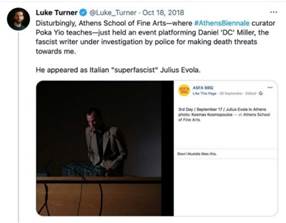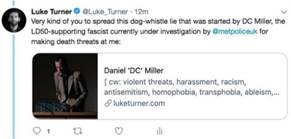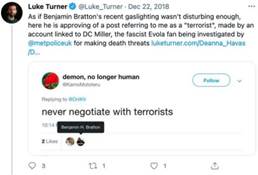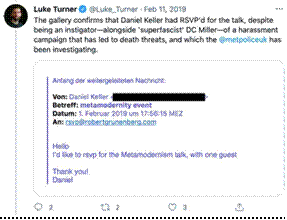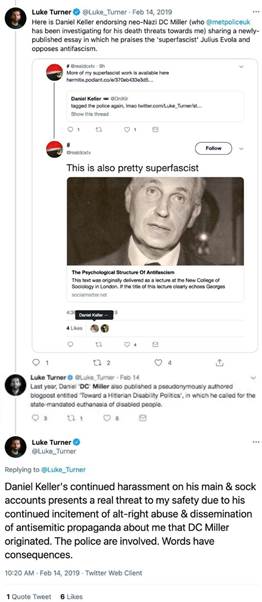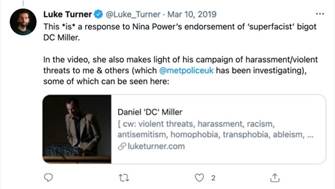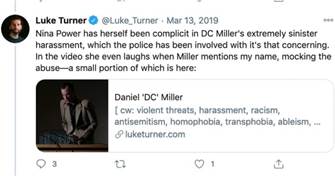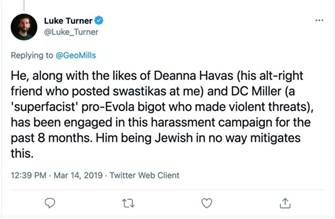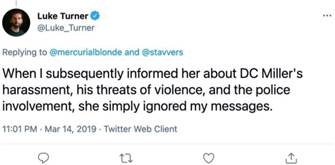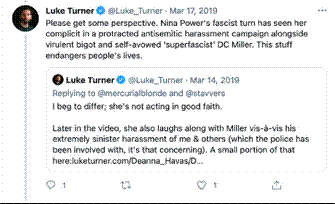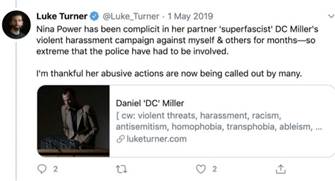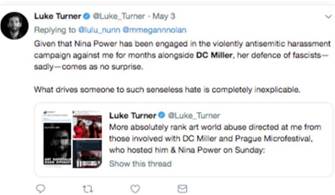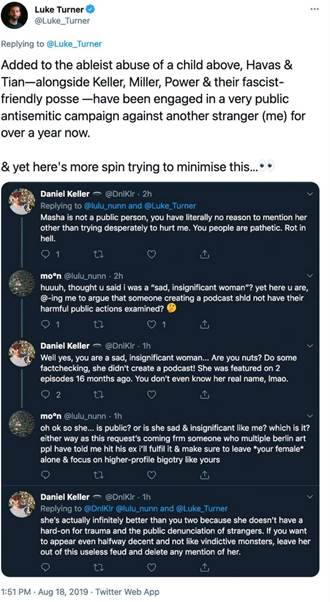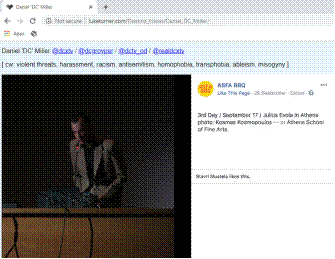Freely Available British and Irish Public Legal Information
[Home] [Databases] [World Law] [Multidatabase Search] [Help] [Feedback]
England and Wales High Court (Queen's Bench Division) Decisions
You are here: BAILII >> Databases >> England and Wales High Court (Queen's Bench Division) Decisions >> Miller & Anor v Turner (Rev3) [2021] EWHC 2135 (QB) (28 July 2021)
URL: http://www.bailii.org/ew/cases/EWHC/QB/2021/2135.html
Cite as: [2021] EWHC 2135 (QB)
[New search] [Printable PDF version] [Help]
Neutral Citation Number: [2021] EWHC 2135 (QB)
Case No: QB-2019-003691
IN THE HIGH COURT OF JUSTICE
QUEEN’S BENCH DIVISION
MEDIA AND COMMUNICATIONS LIST
Royal Courts of Justice
Strand, London, WC2A 2LL
Date: 28/07/2021
Before :
THE HONOURABLE MRS JUSTICE COLLINS RICE
- - - - - - - - - - - - - - - - - - - - -
Between :
|
| (1) DANIEL MILLER (2) NINA POWER |
Claimants |
|
|
- and –
|
|
|
|
LUKE TURNER |
Defendant |
- - - - - - - - - - - - - - - - - - - - -
- - - - - - - - - - - - - - - - - - - - -
Ms Beth Grossman (instructed by Patron Law) for the Claimants
Ms Catrin Evans QC and Mr Jonathan Scherbel-Ball (instructed by Mishcon de Reya LLP) for the Defendant
Hearing date:
30th June 2021
Approved Judgment
Covid-19 Protocol: This judgment was handed down remotely by circulation to the parties’ representatives by email, release to BAILII and publication on the Courts and Tribunals Judiciary website. The date and time for hand-down is deemed to be 12pm on 28th July 2021.
Mrs Justice Collins Rice:
Introduction
1. The Claimants bring a libel action complaining of 17 items (16 tweets and a webpage) about them, published by the Defendant between 18th October 2018 and 18th August 2019. The webpage republished one of the tweets and included links to an ‘archive’ of online material, under a content warning.
2. The First Claimant, Mr Miller, is an American writer on art, philosophy and literature, resident in the UK. He has worked with contemporary artists and international art institutions and exhibitions. He is Jewish.
3. The Second Claimant, Ms Power, is a cultural critic, social theorist, philosopher and translator. She held the post of Senior Lecturer in Philosophy at the University of Roehampton. She was a founder of ‘Defend the Right to Protest’ which supports the United Family & Friends Campaign. One of UFFC’s stated aims is to ensure that minority racial groups are not discriminated against within the criminal justice system.
4. The Defendant, Mr Turner, is an artist and writer based in London. Since 2014 he has been part of the performance art trio LaBeouf, Rönkkö & Turner. LRT came to international attention in January 2017 following the launch of the HEWILLNOTDIVIDE.US durational artwork project, described as a critical response to the election of President Trump. The Defendant is Jewish and describes himself as a vocal opponent of fascism and antisemitism.
5. The publications complained of are set out in a table annexed to this judgment.
6. This judgment determines the single natural and ordinary meanings of the publications complained of; whether the statements complained of comprise statements of fact or of opinion; and to the extent that any statement complained of is opinion, whether it indicates, in general or specific terms, the basis of opinion. It follows a preliminary issues trial, further to an Order of Master Eastman dated 18th February 2021.
General Legal Principles and Approach
7. The applicable legal principles and correct approach are not in dispute. I adopted the standard preparatory approach to determination of meaning. I first read the tweets and webpage complained of, without knowing what either party wanted to say they meant. I formed and noted some provisional views. I then read the trial bundle and the skeleton arguments. I heard oral submissions and reserved judgment.
8. The modern guidance on determining the preliminary issues before me, developed in the accumulated caselaw of the last few years, is relatively detailed. But it is meant to simplify and clarify the exercise, not over-elaborate or complicate it, and the exercise is both ‘impressionistic’ and fact specific. I direct myself to the caselaw in that spirit.
9. I start with the encapsulation of the principles of ‘ordinary and natural meaning’ distilled from the authorities and set out in Koutsogiannis v Random House Group [2020] 4 WLR 25, at paragraphs 11 and 12. My task is to “determine the single natural and ordinary meaning of the words complained of, which is the meaning that the hypothetical reasonable reader would understand the words bear”. The governing principle is reasonableness. The intention of the publisher is irrelevant; the test is objective, not subjective.
10. I keep in mind, as guided, the perspective of an ordinary, reasonable reader of social media of this sort: reading each tweet once through in the context in which it appears, and forming an impression of what is conveyed on their face. The reader is neither naïve nor suspicious; is able to read between the lines and pick up an implication; and is allowed a certain amount of loose thinking without being avid for scandal. Context is important, and ‘common knowledge’ can be factored in, but no evidence beyond the material complained of is admissible as to what it means.
11. I am firmly guided away from over-elaborate analysis of text. That is especially not how tweets are read (Vardy v Rooney [2020] EWC 3156 (QB) at paragraph 18; Stocker v Stocker [2019] 2 WLR 1033 at paragraphs 41 to 47). I need to avoid both literalism, and any strained or forced interpretation. I can and must determine the single meaning I myself consider correct, and am not bound by the meanings advanced by the parties, so long as I do not alight on something more injurious than the Claimants’ pleaded meaning.
12. I have further directed myself to Koutsogiannis at paragraphs 16 and 17 for guidance on considering whether the words complained of contain allegations of fact or opinion. On this, again, the question is how the words would strike the ordinary, reasonable reader. Subject matter and context can be especially important here. “Opinion is something which is or can reasonably be inferred to be a deduction, inference, conclusion, criticism, remark, observation, etc.” but sometimes care is needed: there is a difference between comment which is pure opinion and comment which is an imputation of underlying fact.
13. I am reminded by the authorities (Triplark v Northwood Hall [2019] EWHC 3494 (QB)) that the test for the difference between fact and opinion is an objective one. That comes back to how the words would strike the ordinary reasonable reader. I have to look at the substance, not the intention of the writer or any label the writer may have attached.
14. While there are several preliminary issues I am required to determine, the authorities (see Triplark (paragraph 16) and Barron v Collins [2015] EWHC 1125 (QB) (paragraphs 20-21)) also counsel against the dangers of trying to resolve them in too linear or compartmentalised a fashion. I have to bear in mind whether this is a case in which the questions of ‘meaning’ and ‘fact/opinion’ might throw light on each other, such that it would be wrong to tackle them in an order which proves to be a trap of false logic. I note the risk and seek to avoid it.
The Dispute
15. The parties have pleaded their rival meanings of each item complained of. Their respective contended meanings are set out in the annexed table. Several points arise about the nature of the dispute between them.
16. In the first place, both parties contend that the meaning of each publication is for the most part readily apparent on its face, and the substantial congruence of the meanings contended for largely bears that out.
17. In the second place, the Defendant accepts that, on any of the meanings contended for, these publications complained of are defamatory at common law; in other words, they ‘substantially affect in an adverse manner the attitude of other people towards a claimant, or have a tendency to do so’ (see Triplark at paragraph 11). The determination of meaning, therefore, does not go to any disputed question of defamatory tendency and I am not asked to determine that issue. In these circumstances, the principal purpose of this preliminary issues trial becomes the resolution of the fact/opinion issue (which of course in turn determines the potential availability of the relevant respective defences, should this litigation proceed to future stages).
18. Thirdly, and in consequence, this is a case in which the interplay between the determination of meaning and the determination of fact/opinion acquires some prominence, and as to which I am invited to take particular care. The Claimants contend that all of the content objected to amounts to allegations of fact and that that can be determined simply on a bare reading of the text. The Defendant argues that, on the contrary, reference should be had to a range of contextual material, including embedded hyperlinks and the reading of threads and conversations of tweets as a whole, and that that supports their contention that a certain amount of the content of the individual items complained of should properly be regarded as opinion (deduction, inference, conclusion, etc) based on that material.
19. Fourthly, this has produced a set of rival meaning contentions which vary principally as to scope. The Claimants contend for meanings which are less than what is conveyed by the totality of the words contained in the publications complained of. This is argued on the basis that their claim is founded on objection only to parts of what is said in the publications. The Defendant on the other hand contends for meanings which may be more than the bare information contained in the tweets and webpage. This is argued on the basis of the importance of reflecting context.
20. Fifthly, although a moderately large number of individual items are complained of, the Claimants identify and focus on three principal common themes in the content, to which they object: (a) the theme of allegations of making death-threats towards the Defendant and of associated police investigation; (b) the theme of (other) forms of alleged harassment of him; and (c) the theme of accusation of neo-Nazism and antisemitism. They say that, although single tweets may contain more than one of these allegations, the allegations themselves are distinct and separate.
21. The Claimants do not, however, seek to base their claim on other allegations of a potentially defamatory nature in this material, and in particular they do not choose to found their claim to any degree on allegations that they are fascists (or ‘superfascists’). They say that these allegations are quite distinct from the allegations of neo-Nazism and antisemitism: the former belonging, in context, in the realm of philosophical or artistic debate while the latter constitute specific and factual descriptions of conduct which may be objectively verified. Further, they say that the fascism allegations are irrelevant to the determination of (defamatory) meaning and should be excluded from it. The Defendant, on the other hand, seeks to emphasise that all of the material complained of has to be understood within the context of an overarching narrative about contemporary viewpoints he says are recognisable as pro- or anti-fascist, and that all of the allegations made relate to that narrative, and to each other.
Consideration
22. Having formed my preliminary views as to the meaning and nature of the material complained of, and then absorbed what the parties had to say about the preliminary issues before me, I have reflected in particular on three issues of approach which seemed to me capable of materially affecting my determinations. These are: (1) the potential relevance to meaning of contextual material beyond the words in the publications complained of; (2) the identification and elimination from meaning of possibly irrelevant material contained in the publications complained of; and (3) the interplay between determination of meaning and determination of fact/opinion.
23. The approach I adopted was to begin by considering the first two further with the help of the authorities. I then returned to my original thoughts to make any appropriate adjustments to my provisional conclusions on meaning. Next, I reflected on the fact/opinion question. And finally I considered on a reiterative basis how the meaning and fact/opinion issues fitted together and potentially influenced each other, before reaching my final conclusions.
24. I kept in mind that this is not supposed to be a complex, over-refined or elaborately analytical process. My task is to make determinations which are essentially factual, not legal, standing in the shoes of an ordinary reasonable consumer of the Defendant’s publications. The parties are in substantial agreement about many and perhaps most of the core preliminary issues, and I had quickly reached the same views as the parties, where they agree, on my initial read-through. The analysis below is by way of reasons for or explanation of my conclusions which follow, particularly where the parties did not agree or I have been persuaded that some reassessment of my original views was properly called for. It is not the apparatus of a lawyerly reading of these texts; I have been alert to resist any temptation to substitute such a thing for the simple and straightforward task on which I must remain focused.
(i) Reading tweets in context
25. The parties do not materially dispute the principles which have specific relevance to the reading of tweets. I have directed myself to Monroe v Hopkins [2017] 4 WLR 68 at [34] to [41] for its useful summary of those principles, and the well-known characterisation of Twitter as a fast-moving multi-dimensional conversational medium. Determining the meaning of a tweet is an impressionistic exercise, but ‘this impressionistic approach must take account of the whole tweet and the context in which the ordinary reasonable reader would read the tweet. That context includes … matters that were put before the reader via Twitter’. That has two consequences for the determination of meaning.
26. First, the ordinary, reasonable readership of tweets may be taken to have some contextual awareness of the authorship and subject-matter of the tweets. They may be followers (either pro- or anti- the author) or they may encounter the material by way of retweets (here, the rate of retweet appears to be very low). The reader is sufficiently interested in the author or the subject matter to read the publications complained of and form an impression of the themes and the author’s general outlook. But no particular characteristic of the readership is otherwise proposed which could have a bearing on meaning.
27. Second, regard may be had to two categories of material beyond the words and images of a particular tweet where that is capable of affecting meaning. The first is material found via links included in the tweet. The second is other ‘material sufficiently closely connected in time, content or otherwise that is likely to have been in the hypothetical reader’s view, or in their mind, at the time they read the words complained of’ - for example adjacent tweets in a conversation or thread. However, there is infinite variability in the immediate context in which a tweet may be read, so Twitter is ‘perhaps one of the most inhospitable terrains for any argument based on the context in which any particular Tweet appeared in a reader’s timeline’ (Riley v Murray [2020] EWHC 977 (QB) at [28]).
28. These are common-sense principles. Their application to any particular set of tweets depends almost entirely on the extent to which the ordinary and natural meaning of the tweets will not readily yield itself without the assistance of aids to understanding of this sort. That is highly fact-specific. Sometimes a tweet is unintelligible without reference to material incorporated or annexed in this way. Sometimes the ostensible meaning can be changed when its connectedness to other material is realised. Sometimes contextual material can amplify or clarify meaning. In these cases, questions may arise about whether and how the ordinary reader might use context to form an understanding. But sometimes it is just interesting background to a tweet whose meaning is already apparent and contained on its face. It all depends. Determining ordinary and natural meaning requires taking a view about how far the infinite potential contextualisation available on Twitter does, or needs to, bear on the ordinary reader’s understanding of what they are reading.
29. It all remains a quintessentially impressionistic exercise. Tweets are consumed in a second or two and the ordinary reader - who, while interested, is not a devotee or expert, nor engaged in a research exercise - moves on. The Defendant says the readership of his publications may be taken to be more attentive, serious-minded or reflective than the average. Nevertheless, it is the sheer pace with which individual tweets emerge briefly from the vastness of the social media context, are consumed, and are instantly replaced in ordinary readers’ attention, which remains their characteristic experience.
30. If the current state of the law on determining the meaning of tweets imposes any particular analytical challenge in relation to context, it is to maintain the distinction between ordinary and natural (but contextualised) meaning on the one hand, and innuendo meaning on the other; and the distinction between context (which is important) and external evidence of meaning (which is impermissible). These are conceptual distinctions in law, but potentially shades on a spectrum in practice. While this analytical challenge was raised before me in this case, no innuendo meaning is pleaded or relied on. No special meaning which depends on particular knowledge is to be pursued. A common-sense approach to the relevance, or otherwise, of immediate context to the determination of ordinary and natural meaning is paramount. Tweets are read at speed and over-analysis must be avoided. That applies both to attempts to gloss meaning with what is in effect commentary on the text, and to attempts to bring in contextual material in an effort to yield a more sophisticated reading than there is realistic time for.
31. Keeping all of this at the back (but not the front) of my mind in re-reading the publications complained of in this case, I have found for the most part that it has not been necessary or desirable to have significant reference beyond the material contained in the tweets themselves for their ordinary and natural meaning to yield itself. I have not, however, closed my mind to the potential relevance of contextual material when reflecting on the potential interplay between meaning and fact/opinion, as considered below.
(ii) Identifying relevant meaning
32. Any exercise in determining meaning in a defamation claim is likely to find that the publication complained of consists of a quantity of uncontroversial or scene-setting content, and the potentially defamatory nub, the meaning and/or fact/opinion status of which is in dispute. The court’s determination will generally focus on the nub of the matter. So, for example, where a newspaper article is complained of, the determination of meaning will not necessarily parse the whole piece (which remains relevant context nevertheless), but may focus on the paragraph or two containing the potentially defamatory ‘sting’, or give an overall summary of such part of the meaning as may be thought to furnish the subject-matter of the claim.
33. Where tweets are complained of, the intrinsic limitations of the medium mean it may be simpler and more accurate to determine the meaning of the whole tweet. It is just too short a sample of text to warrant spending analytical time and effort routinely on distinguishing between the nub and the rest; that is not how they are read, and nothing usually turns on it.
34. In this case, however, the Claimants are keen for me to do so. They rely on Swan v Associated Newspapers Ltd [2020] EWHC 1312 (QB) at [23]-[25]. They say the publications complained of contain a number of separate and distinct defamatory imputations, and they are entitled to limit their claim to one or more of those imputations (in this case, imputations relating to death threats, police investigation, harassment, neo-Nazism/antisemitism). They say that ‘it is not open to a defendant to expand the parameters of the claim by advancing a defence to other potentially actionable imputations of which no complaint was made’ (in this case, imputations relating to fascism). They then seek to build on these uncontroversial propositions to contend for meanings of the tweets which effectively edit out any reference to fascism on the ground of irrelevance.
35. The issue in Swan was whether the publication complained of (a single newspaper article) contained ‘a general charge’ or ‘a specific imputation or imputations’. That is of course ‘a question of fact and degree in each case’. The court provided some ‘useful tests’ to help a court which is trying to answer this question. I am not, however, persuaded that it is a question which genuinely arises in this case.
36. I agree the Claimants are entitled to identify thematic objections in the publications complained of, and to argue their case accordingly. They are entitled to, and do, seek to demonstrate that each tweet complained of has a meaning which articulates one or more of these themes. They are entitled to make clear that allegations of fascism form no part of their claim; if they wish to reserve their position on allegations of fascism on the basis that it may be consistent with a philosophical or esoteric/artistic position about which free expression may be acknowledged, then that is a matter for them. Their position is evidently based on a proposition that in this context the distinction between allegations of fascism and of neo-Nazism or antisemitism is highly material: the terms are not interchangeable, and the latter belong firmly outside any arguable philosophical debating arena. The Claimants are entitled to require the Defendant to answer the claim made and no other.
37. Equally, whether the specific imputations belong in a common narrative (fascism vs anti-fascism) was canvassed before me on behalf of the Defendant, and may be relevant to the future defence of his opinions: it is evident that the Defendant objects to the Claimants’ world-view on a fairly general basis, and considers those objections to be laid out and sustained in the publications complained of, and in associated contextual material, in a consistent and systematic way.
38. But these are all issues for another day. This is not a case in which either party has sought to insist on a ‘general charge’ as opposed to ‘specific imputations’ in their pleaded meanings. The ordinary and natural meaning of these tweets needs to be determined simply, quickly, objectively and as a whole. I find no basis in Swan or on the facts and pleadings of this case for doing what the Claimants invite me to do, which is to edit out references to allegations of fascism in determining the meaning of these individual tweets.
39. Monroe v Hopkins gives a clear steer that the impressionistic exercise of determining the meaning of a tweet must take account of the whole tweet. The court in Swan was, in addition to the point relied on by the Claimants, also at pains to point out that ‘a claimant cannot seek artificially to narrow or circumscribe the claim by selective complaint of words or passages taken out of context; and conversely a defendant is entitled to point to other passages in an article in order to aver that the words in their context bear a different and/or wider meaning from that alleged’.
40. Determining meanings here which redact references to fascism (including from the middle of sentences) is artificial, inappropriate and unnecessary. Not every word which appears in a publication complained need belong to the defamatory nub of a claim. The Claimants are at liberty to insist in due course that mentions of fascism belong in the uncomplained of penumbra rather than the complained of core of the objection to these publications. But that does not justify a determination of meaning which redacts those references on a word-by-word basis or creates a fiction that those words have not been written (or read). That contravenes the warning in Swan against artificial circumscription and selective complaint of words or passages stripped of context. The relevance of that close context may itself be a matter for future debate, but it is undeniably there.
41. My reflection on the interplay of meaning and fact/opinion, set out below, reinforces me in that view.
42. I have instead taken the straightforward route of rendering a meaning - on an item-by-item basis as the parties agree in proposing - of each brief publication complained of in its entirety so far as it relates to the Claimants. The meaning of the tweets must be taken as a whole. The determination of natural and ordinary meaning is not an exercise in editorial filleting.
(iii) The Interplay of Meaning and Fact/Opinion
43. The Defendant is broadly content to recognise allegations on the themes of death threats, police investigation and harassment as being essentially factual. I agree with that. They are potentially objectively verifiable or disprovable allegations that the Claimants have done something and that those actions have had consequences.
44. The parties take issue, however, with the classification of allegations of neo-Nazism or antisemitism. In principle, allegations of this sort may be either factual, or deduction, inference, conclusion, criticism, remark, observation, etc, depending on all the circumstances of the case. It comes down to how the allegations in context would strike the ordinary reasonable reader.
45. On the facts of this particular case, the Defendant argues that the full context of material sufficiently closely connected is an important part of the classification exercise, and that it is particularly relevant in this case to look at meaning and classification together, and through this lens. He says doing so demonstrates that the tweets complained of rest upon a substructure of information, predominantly factual information, about the Claimants in particular and the contextual narrative of a contemporary fascism/anti-fascism debate in general. He says this substructure both establishes the allegations of neo-Nazism/antisemitism to be deductive conclusion or opinion, and indicates the basis on which such opinion has been reached.
46. I have reflected on this. The existence of a substructure of information is not itself determinative, or even reliably suggestive, that allegations amount to either opinion or fact. That substructure may comprise a body of historical evidence, speaking for itself and going to the basis of a factual allegation. Or it may comprise a set of examples from which evaluative conclusions have been drawn. It may be a mixture. It all depends on the case.
47. Where I had initially identified allegations as either fact or opinion, I have reviewed those provisional conclusions, and my conclusions on meaning, to see how far they might shed useful light on each other. I have sought, without over-labouring the exercise, to test whether each allegation made amounts to a factual assertion as to beliefs manifested or things done, or whether it is an expression of the Defendant’s comment or opinion on people or events.
48. Whether any given allegation of neo-Nazism or antisemitism is an allegation of fact or an expression of opinion is context-sensitive, but I must keep the objective perspective of the ordinary reader firmly in mind. The most relevant context here is the most immediate - the content of the tweets themselves. I think the ordinary reader would quickly get the impression from this material that where epithets are directed to the Claimants they are clearly in the realms of evaluative opinion. I am confirmed in my earlier view that the allegations of being fascists (or alt-right), whether or not complained of, are a relevant part of the meaning of the tweets in this respect, because they contribute to an overall impression that the Claimants and their world-view are being critiqued or evaluated by all of these epithets. (The same goes for the string of epithets appearing in the content warning on the webpage.) They are certainly different epithets, and the difference may arguably be significant, but in my view they convey an overall impression to the ordinary reader that the Defendant is expressing his (strong) views about the Claimants.
49. Where the epithets are directed to describing a campaign or propaganda I have had more pause for thought. It is possible in theory for a more objective or factual assessment to be made of materials or events than of people and their views. I have however concluded that, taking contextual material into account at least to the extent of looking at the cumulative impression created by all of the publications complained of, the allegations here too are in the realm of opinion. The impression created by a quick read through is that these examples also partake of the overall critique of the Claimants, their associates and their world-view - they would be absorbed by the ordinary reader as part of the Defendant’s sustained polemic rather than as purporting to chronicle historically and objectively factual matters. ‘Propaganda’ itself is a value-laden term.
50. Section 3(3) of the Defamation Act 2013 provides that the defence of ‘honest opinion’ requires that a statement of opinion complained of has ‘indicated’, whether in general or specific terms, the basis of the opinion. The indication of basis may appear intrinsically (within the tweet itself) or extrinsically by means of references to other material.
51. Where I have identified an expression of opinion, I have also identified the extent to which it appears to me that the basis of that opinion is indicated - on the face of the publication complained of or supplied referentially or contextually. I have, however, limited the exercise of identifying basis of opinion to those opinions to which I understand the Claimants to object in their claim - that is, to allegations about neo-Nazism and antisemitism.
52. For the avoidance of doubt (having regard to the Defendant’s pleaded meanings), ‘basis of opinion’ is not relevant to allegations of fact, and ‘basis of fact’ forms no part of this preliminary issues ruling.
Conclusions
53. My conclusions on the preliminary issues follow. I consider each item in turn. I have adopted the numbering of the items in the annexed table. In each case, I set out my conclusion on natural and ordinary meaning in italics. I have adopted the convention of identifying opinion by means of underlining; otherwise my conclusion is that what is said amounts to an allegation of fact. I have excluded only matters which do not appear to be about the Claimants. Such item-by-item commentary as appears desirable, including by way of particular reasons for my determination, or indication of basis of opinions objected to, follows in square brackets.
(1) The First Claimant is a fascist writer. He appeared at an event at the Athens School of Fine Arts in the guise of Julius Evola (who is a superfascist). This is disturbing. The First Claimant is being investigated by the police. This is because he has made death threats towards the Defendant.
[I do not find a sufficiently proximate basis for limiting the meaning of the allegation of making death threats to having done so online (only). I consider the allegations of death threats to be at ‘Chase level 1’: that is to say, the meaning is not that the police are investigating whether the First Claimant has made death threats, but rather that the police have become involved because he has made death threats. However, contrary to the Claimants’ contention, no necessary criminal quality of those threats is to be read into the mere fact of a police investigation, as an investigation may be anywhere on a spectrum from the inconsequential to the serious. The tweet itself indicates the basis for the ‘disturbing’ opinion.]
(2) The First Claimant is a fascist who supports the London art gallery LD-50. He started the lie referred to. He is under investigation by the police. This is because he made death threats to the Defendant.
(3) The First Claimant has been associated with calling the Defendant a terrorist. He is a fascist Evola fan. He is being investigated by the police. This is because he made death threats to him also.
(4) (i) The First Claimant is a superfascist. He instigated a harassment campaign that has led to death threats. The police are investigating this.
(ii) The First Claimant is a neo-Nazi. He is being investigated by the police. That is because he made death threats towards the Defendant.
(iii) The First Claimant has published, under a pseudonym, a blogpost titled ‘Towards a Hitlerian Disability Politics’. In this, he called for state-mandated euthanasia of disabled people.
(iv) The First Claimant originated a campaign of alt-right abuse and antisemitic propaganda about the Defendant which others have continued and developed. The police are involved.
[The indicated basis of the opinion that the First Claimant is a neo-Nazi is the blog post mentioned at (iii). The indicated basis of the opinion in (iv) is the alleged fact of the First Claimant’s origination of a campaign of abuse and propaganda, and the elaboration of that in the rest of the thread, particularly by reference to the development of the campaign by others as identified.]
(5) The First Claimant is a superfascist bigot. The Second Claimant supports his views. The First Claimant is responsible for a campaign of harassment and violent threats to the Defendant and others, which the police are investigating. The Second Claimant makes light of that. The Second Claimant has made a video which demonstrates this.
[The indicated basis of the opinion that the Second Claimant made light of the First Claimant’s campaign is the video referred to.]
(6) The First Claimant has been responsible for extremely sinister harassment of the Defendant. The police have been involved because it is so concerning. The Second Claimant is complicit in the harassment. She appears in a video in which she laughs when the First Claimant mentions the Defendant’s name and mocks the abuse.
[The indicated basis of the opinion that the First Claimant’s campaign is ‘extremely sinister’ is the embedded tweet and the link to the ‘archive’ found there. The indicated basis of the opinion that the Second Claimant is complicit in and mocks the abuse/harassment of the Defendant by the First Claimant is the video referred to.]
(7) The First Claimant is a superfacist pro-Evola bigot. He has made violent threats. With others, he has been engaged in a harassment campaign against the Defendant for the previous 8 months.
(8) The First Claimant is responsible for harassment and threats of violence against the Defendant. The police are involved.
(9) The First Claimant is a virulent bigot and has self-avowed that he is a superfascist. The Second Claimant has demonstrated a fascist turn. She is not acting in good faith. The First Claimant is responsible for a protracted harassment campaign against the Defendant and others which is antisemitic, and that is extremely sinister. The police have been involved because it is so concerning. It is behaviour which endangers lives. The Second Claimant has been complicit in that campaign. In her video she laughs along with the First Claimant about the harassment.
[The indicated basis of the opinion of the Second Claimant’s complicity is the video referred to. The opinions about the campaign being ‘sinister’ and ‘concerning’ are commentary on the facts alleged in the tweet and on the allegation of antisemitism. The indicated basis of the opinion about the antisemitic character of the campaign is the hyperlinked thread of tweets.]
(10) The First Claimant is a superfascist. He has been conducting a violent harassment campaign against the Defendant and others for months. The police have been involved because the campaign is so extreme. The Second Claimant has been complicit in the campaign. The First Claimant is her superfascist partner in this respect. Her actions are abusive.
[The indicated basis for these opinions is the embedded tweet and the link to the ‘archive’ found there.]
(11) The First Claimant has been engaged for months in a violently antisemitic campaign against the Defendant and others. The Second Claimant has been engaged alongside him. This demonstrates that she has been driven to inexplicable senseless hate. Her defence of fascists is in these circumstances no surprise.
[Notwithstanding the direct allegations of violence in other tweets complained of, the quick, impressionistic reading of ‘violently antisemitic campaign’ suggested the virulence of the antisemitism rather than the violence of the campaign. The basis for this opinion is indicated by reference to the thread in which it appears, the tweet to which it replies (and the rest of that conversation), and the tweet and thread embedded.
In my view this tweet goes beyond an allegation of opinion (or value judgment) regarding the Second Claimant’s ‘complicity’, by making a factual allegation that she has been engaged in the campaign. I have reflected on whether that is a potentially worse reading than the Claimants’ pleaded meaning that she has (in fact) been ‘complicit’. One of the reasons I have otherwise regarded ‘complicity’ in the contexts in which the term itself appears in the publications complained of as belonging to the realms of comment rather than factual allegation is its generality or vagueness. So I have concluded that a factual allegation of being ‘engaged alongside’ is consistent with, and not worse than, a pleaded meaning couched in terms of a ‘factual allegation of complicity’; the latter encompasses a wide spectrum of conduct. If there are shades of meaning in the difference, they are at a level of textual exegesis a good way beyond the scope countenanced for determination of ordinary and natural meaning.]
(12) The Second Claimant is an antisemitic art-world figure. She appeared, with others, at an art event in Berlin. This was a propaganda event.
[The indicated basis for these opinions may be found by clicking on to the embedded link to the @spike_art twitterfeed and reading about the Berlin event.]
(13) Both Claimants are part of a fascist-friendly art-world posse. With others in that group, they have been engaged in a very public antisemitic campaign against the Defendant for over a year.
[The basis for the opinion about the nature of the campaign is indicated by the rest of the thread and the embedded or linked material.]
(14) The material available via this webpage is about the First Claimant. It shows he is racist, antisemitic, homophobic, transphobic, ableist and misogynistic. He has issued violent threats and caused harassment.
[The indicated basis for these opinions is the embedded tweet and the hyperlinked ‘archive’ material indicated.]
|
|
Reference in Particulars of Claim |
Tweet Complained of |
Claimants' Natural and Ordinary Meaning (pursuant to paragraphs 10 – 11 of the Amended Particulars of Claim)
|
Defendant’s Natural and Ordinary Meaning (opinion underlined, otherwise factual |
|
1 |
4.1 on 18 October 2018
|
|
C1 has made criminal threats to kill the Defendant for which he is being investigated by the police |
C1 is the fascist writer under investigation by police for making online death threats towards the Defendant. |
|
2 |
4.2 on 20 November 2018
|
|
C1 has made criminal threats to kill the Defendant for which he is being investigated by the police |
C1 is the LD50 supporting fascist currently under investigation by police for making online death threats at LT. |
|
3 |
4.3 on 22 December 2018
|
|
C1 has made criminal threats to kill the Defendant for which he is being investigated by the police |
C1 is the fascist Evola fan being investigated by the police for making online death threats, as recorded in the embedded archive on “Daniel DC Miller”. |
|
4 |
4.4 on 11 February 2019 and 4.5.1, 4.5.2, and 4.5.3 on 14 February 2019
|
|
Regarding 4.4, C1 is guilty of instigating a violent campaign of harassment against the Defendant that has led to criminal threats to kill the Defendant being made, which are being investigated by the police
Regarding 4.5.1, C1 is guilty of having committed a criminal offence by creating and disseminating antisemitic propaganda about the Defendant, as a result of which he will face serious legal consequences
Regarding 4.5.2, C1 has made criminal threats to kill the Defendant for which he is being investigated by the police. Additionally, C1 is a Neo-Nazi.
Regarding 4.5.3, C1 is an antisemite who espouses Nazi ideology having pseudonymously authored a blogpost entitled 'Toward a Hitlerian Disability Politics' in which he called for the state-mandated euthanasia of disabled people
|
The neo-Nazi “superfascist” C1 was involved in an online campaign of alt-right abuse and antisemitic harassment against the Defendant which included death threats and which the police were investigating. |
|
5 |
4.6 on 10 March 2019
|
|
C1 has made criminal threats to kill the Defendant for which he is being investigated by the police. Additionally, such criminal threats have been made as part of a campaign of harassment against the Defendant |
2. C1 has been involved in an online campaign of harassment and violent threats to the Defendant and others which the police have been investigating, as exemplified by the instances recorded in the Defendant’s embedded archive on “Daniel DC Miller”
|
|
6 |
4.7 on 13 March 2019
|
|
|
|
|
7 |
4.8.1 on 14 March 2019 |
|
C1 is guilty of carrying out a violent campaign of harassment against the Defendant |
C1 was a "superfascist" pro- Evola bigot who had been, with others, engaged in a prolonged antisemitic online harassment campaign against the Defendant, including violent threats. |
|
8 |
4.8.2. on 14 March 2019
|
|
C1 is guilty of carrying out a violent campaign of harassment against the Defendant. Additionally, the campaign he has carried out against the Defendant amounts to a criminal offence and is so serious that it has required police involvement |
C1 had been involved in the extremely sinister online harassment of the Defendant, including threats of violence and as to which the police had been involved. |
|
9 |
4.9 on 17 March 2019
|
|
1. C1 is guilty of carrying out a violent campaign of harassment against the Defendant. Additionally, the campaign he has carried out against the Defendant has been antisemitic in nature
2. C2 has been complicit in the C1's violent and lengthy campaign of antisemitic harassment against the Defendant
|
|
|
10 |
4.10 on 1 May 2019
|
|
2. C2 has been complicit in the C1's violent criminal campaign of harassment against the Defendant, which has included C1 making threats to kill the Defendant, and which is so serious that it has required police involvement
|
2. C2 had been complicit in C1’s online campaign against the Defendant, and the Defendant was thankful that C2’s abusive actions were
|
|
11 |
4.11 on 3 May 2019
|
|
2. C2 has been complicit in the C1's violent and lengthy campaign of antisemitic harassment against the
|
|
|
12 |
4.12 on 26 May 2019
|
|
C2 is antisemitic |
C2 is an antisemitic art world figure who had appeared alongside Mathieu Malouf in a propaganda event staged that week by @spike_art in Berlin, which is concerning in light of the reports of a rise in antisemitism in Germany. |
|
13 |
4.13 on 18 August 2019 |
|
|
C1 and C2, and other fascist-friendly artworld figures, have engaged in a very public antisemitic online campaign against the Defendant for over a year. |
|
14 |
Paragraph 6 – The Archive |
|
C1 is racist, antisemitic, homophobic, transphobic, ableist and misogynistic and is guilty of having carried out a campaign of violent threats and harassment against the Defendant, which has included making threats to kill the Defendant, for which he is being investigated by the police |
C1 had been involved in a bigoted, fascist and antisemitic online harassment campaign against the Defendant that had included violent and abusive threats. |

